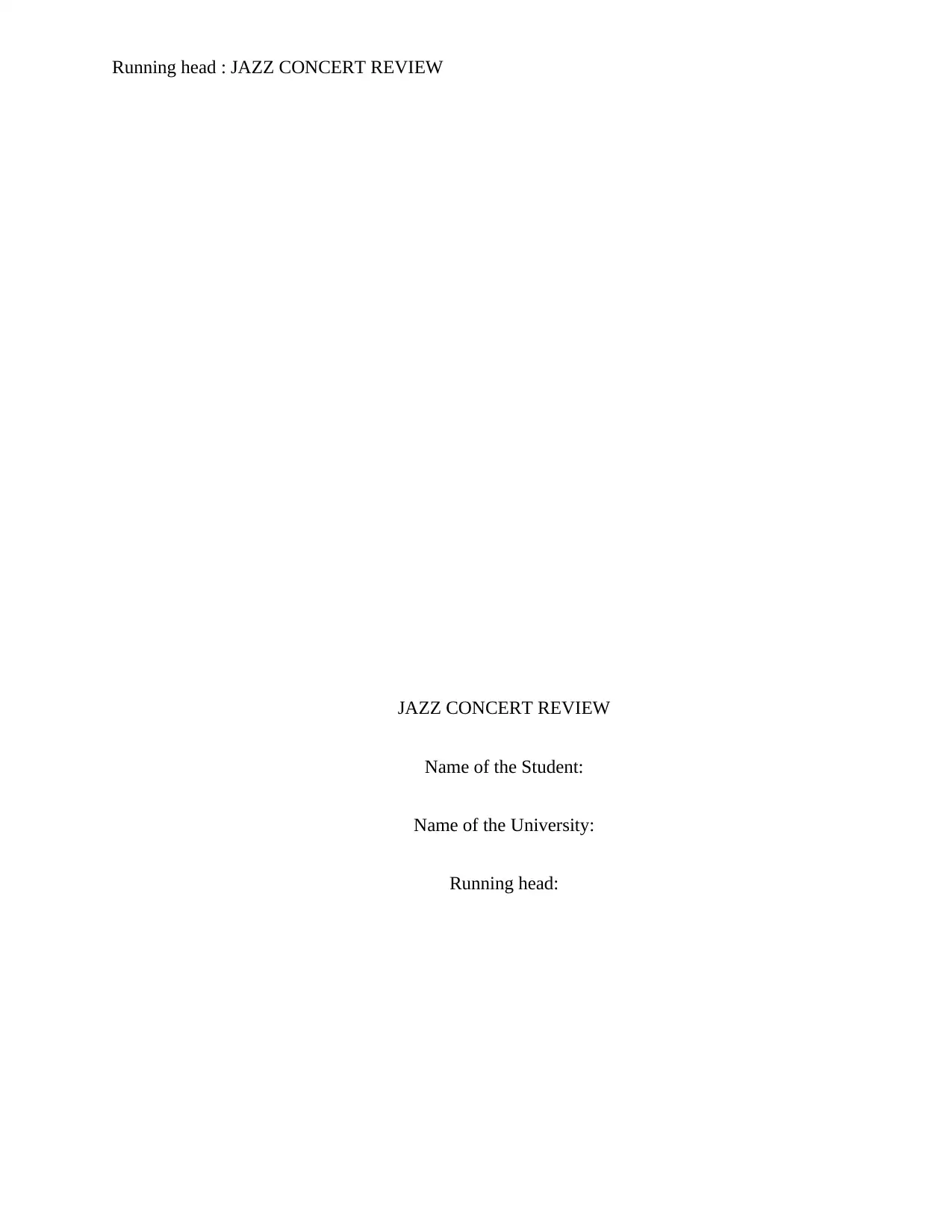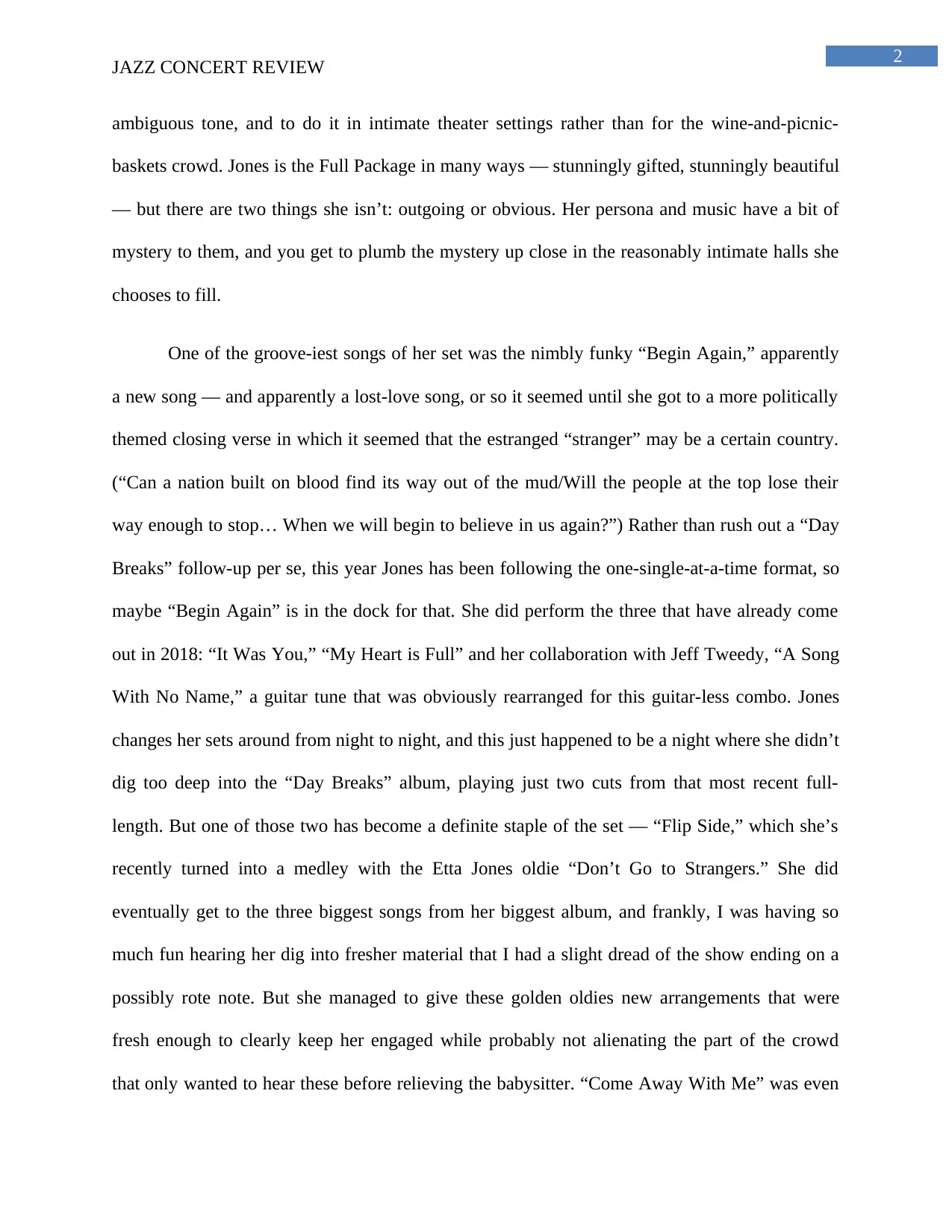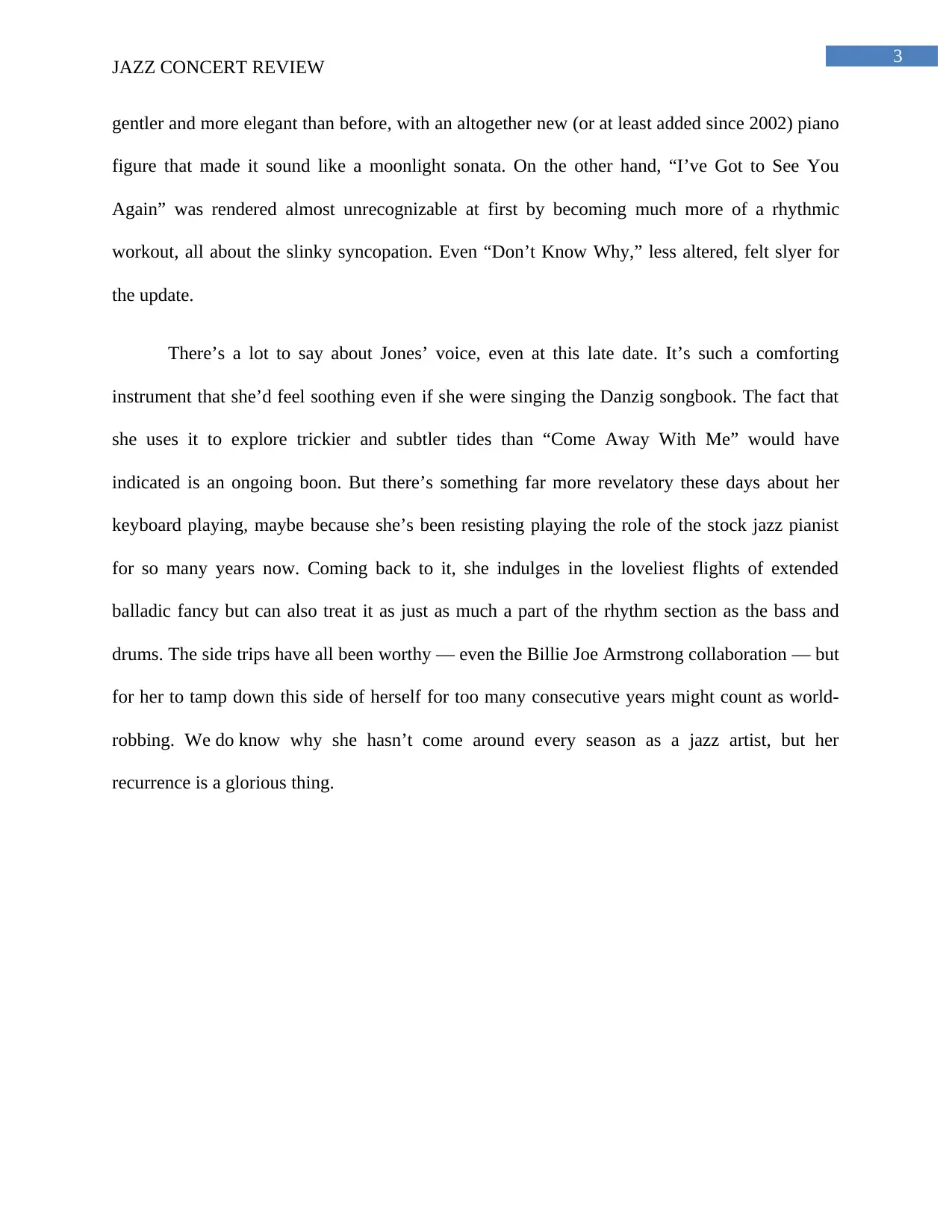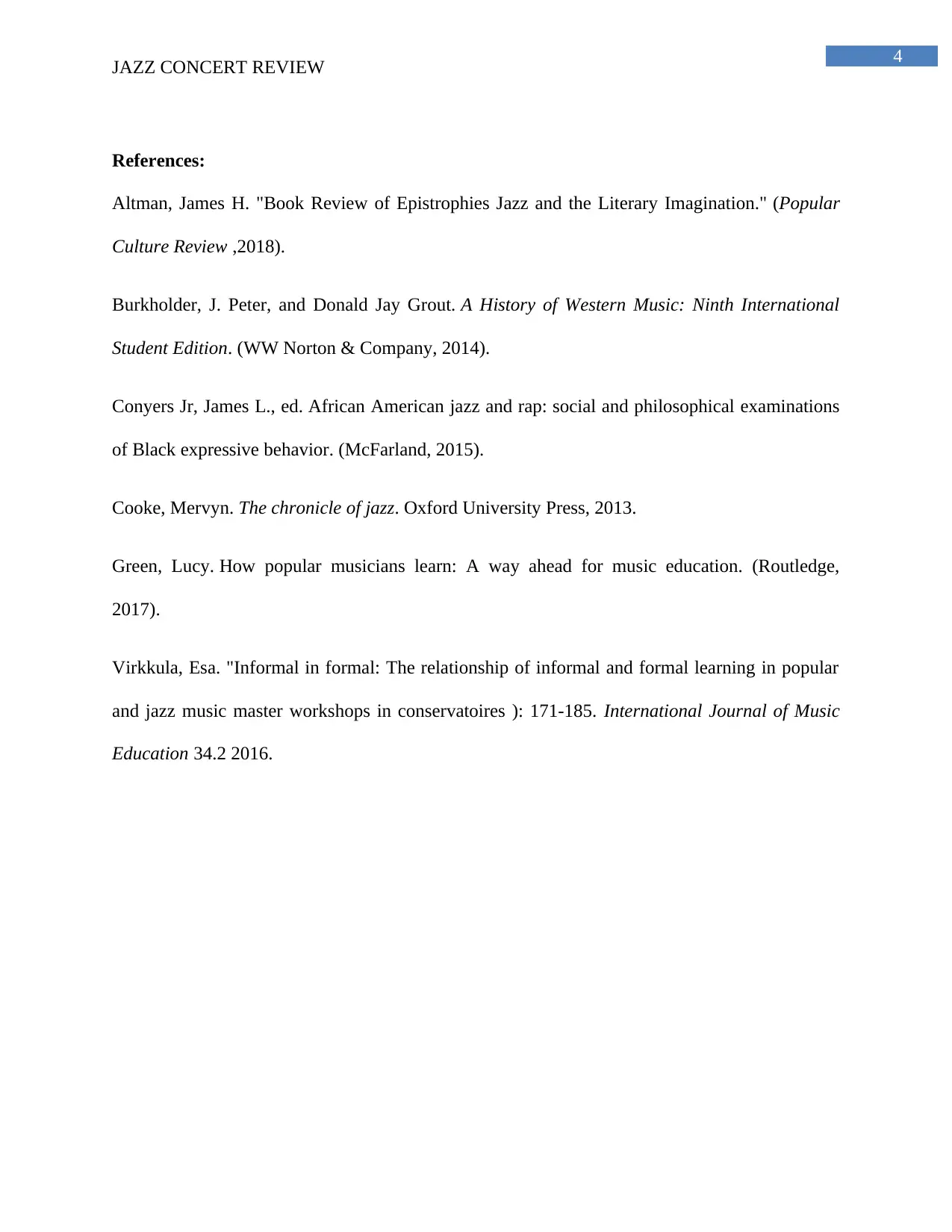Jazz Performance Review: Norah Jones at the Theatre Ace Hotel, L.A.
VerifiedAdded on 2023/05/30
|5
|1336
|338
Report
AI Summary
This report presents a review of Norah Jones' recent jazz concert at L.A.’s Theatre at Ace Hotel, focusing on her return to a minimalist jazz combo format and her genre fluidity. The concert included a mix of original material, covers such as Hank Williams’ “Cold Cold Heart” and Tom Petty’s “Angel Dream,” and hits from her album “Come Away With Me.” The reviewer notes Jones' ability to blend jazz with elements of rock and Americana, creating a unique and engaging performance. Special attention is given to her keyboard playing and her evolution as an artist, highlighting her choice to focus on original material and intimate theater settings. The review also touches on the political themes in her new song “Begin Again” and the fresh arrangements of her older hits, emphasizing Jones' ongoing artistic growth and her ability to keep her performances engaging.

Running head : JAZZ CONCERT REVIEW
JAZZ CONCERT REVIEW
Name of the Student:
Name of the University:
Running head:
JAZZ CONCERT REVIEW
Name of the Student:
Name of the University:
Running head:
Paraphrase This Document
Need a fresh take? Get an instant paraphrase of this document with our AI Paraphraser

1
JAZZ CONCERT REVIEW
I was apparently hesitant when my friends told me that Norah Jones is making a
comeback this year and they are all going for her show. Honestly, I have never been a huge fan
of jazz music. Not that she ever entirely went away, or probably cares about our genre
distinctions much anyway, but her sold-out show at L.A.’s Theatre at Ace Hotel this week felt
like a sort of homecoming, making good live on what she’d delivered on her most recent album,
2016’s “Day Breaks.” It was a return to a minimalist jazz combo format and sound, but not
coming back with her tail between her legs; her current music is much too informed by her
forays into rock and Americana for that. No one should have been fooled by the minimal drums-
bass-organ backing into thinking Jones has gone into a state of regress: Even back on her most
familiar musical turf, Jones rocked the show.
At the Ace show, Jones opened with “Cold Cold Heart,” the Hank Williams cover that
helped establish her genre fluidity when she included it on her debut, “Come Away With Me,” in
2002. Later, she did a gorgeously plaintive version of Tom Petty’s underrated “Angel Dream.”
(Jones is no Jenny-come-lately when it comes to appreciating Petty. Her tributes to the late
rocker go back `into the pre-posthumous realm, as she sang two others of his songs at the local
PettyFest salute at the Fonda in 2016 and at the MusiCares benefit in 2017.)
But, those examples notwithstanding, covers are not really her thing, so much. She could
easily have had the Diana Krall career (not that there’s anything wrong with the Diana Krall
career) by emphasizing, if not the Great American Songbook, jazzy versions of the great pop-
rock songbook on tour in giant sheds around America every summer. At the very least, she could
have focused on romantic material, of the sort that helped push “Come Away With Me” to
diamond (10-million-selling) status and five Grammys. But, beyond drifting in and out of that
seminal pop-jazz style, she’s chosen to focus on original material that often has a more
JAZZ CONCERT REVIEW
I was apparently hesitant when my friends told me that Norah Jones is making a
comeback this year and they are all going for her show. Honestly, I have never been a huge fan
of jazz music. Not that she ever entirely went away, or probably cares about our genre
distinctions much anyway, but her sold-out show at L.A.’s Theatre at Ace Hotel this week felt
like a sort of homecoming, making good live on what she’d delivered on her most recent album,
2016’s “Day Breaks.” It was a return to a minimalist jazz combo format and sound, but not
coming back with her tail between her legs; her current music is much too informed by her
forays into rock and Americana for that. No one should have been fooled by the minimal drums-
bass-organ backing into thinking Jones has gone into a state of regress: Even back on her most
familiar musical turf, Jones rocked the show.
At the Ace show, Jones opened with “Cold Cold Heart,” the Hank Williams cover that
helped establish her genre fluidity when she included it on her debut, “Come Away With Me,” in
2002. Later, she did a gorgeously plaintive version of Tom Petty’s underrated “Angel Dream.”
(Jones is no Jenny-come-lately when it comes to appreciating Petty. Her tributes to the late
rocker go back `into the pre-posthumous realm, as she sang two others of his songs at the local
PettyFest salute at the Fonda in 2016 and at the MusiCares benefit in 2017.)
But, those examples notwithstanding, covers are not really her thing, so much. She could
easily have had the Diana Krall career (not that there’s anything wrong with the Diana Krall
career) by emphasizing, if not the Great American Songbook, jazzy versions of the great pop-
rock songbook on tour in giant sheds around America every summer. At the very least, she could
have focused on romantic material, of the sort that helped push “Come Away With Me” to
diamond (10-million-selling) status and five Grammys. But, beyond drifting in and out of that
seminal pop-jazz style, she’s chosen to focus on original material that often has a more

2
JAZZ CONCERT REVIEW
ambiguous tone, and to do it in intimate theater settings rather than for the wine-and-picnic-
baskets crowd. Jones is the Full Package in many ways — stunningly gifted, stunningly beautiful
— but there are two things she isn’t: outgoing or obvious. Her persona and music have a bit of
mystery to them, and you get to plumb the mystery up close in the reasonably intimate halls she
chooses to fill.
One of the groove-iest songs of her set was the nimbly funky “Begin Again,” apparently
a new song — and apparently a lost-love song, or so it seemed until she got to a more politically
themed closing verse in which it seemed that the estranged “stranger” may be a certain country.
(“Can a nation built on blood find its way out of the mud/Will the people at the top lose their
way enough to stop… When we will begin to believe in us again?”) Rather than rush out a “Day
Breaks” follow-up per se, this year Jones has been following the one-single-at-a-time format, so
maybe “Begin Again” is in the dock for that. She did perform the three that have already come
out in 2018: “It Was You,” “My Heart is Full” and her collaboration with Jeff Tweedy, “A Song
With No Name,” a guitar tune that was obviously rearranged for this guitar-less combo. Jones
changes her sets around from night to night, and this just happened to be a night where she didn’t
dig too deep into the “Day Breaks” album, playing just two cuts from that most recent full-
length. But one of those two has become a definite staple of the set — “Flip Side,” which she’s
recently turned into a medley with the Etta Jones oldie “Don’t Go to Strangers.” She did
eventually get to the three biggest songs from her biggest album, and frankly, I was having so
much fun hearing her dig into fresher material that I had a slight dread of the show ending on a
possibly rote note. But she managed to give these golden oldies new arrangements that were
fresh enough to clearly keep her engaged while probably not alienating the part of the crowd
that only wanted to hear these before relieving the babysitter. “Come Away With Me” was even
JAZZ CONCERT REVIEW
ambiguous tone, and to do it in intimate theater settings rather than for the wine-and-picnic-
baskets crowd. Jones is the Full Package in many ways — stunningly gifted, stunningly beautiful
— but there are two things she isn’t: outgoing or obvious. Her persona and music have a bit of
mystery to them, and you get to plumb the mystery up close in the reasonably intimate halls she
chooses to fill.
One of the groove-iest songs of her set was the nimbly funky “Begin Again,” apparently
a new song — and apparently a lost-love song, or so it seemed until she got to a more politically
themed closing verse in which it seemed that the estranged “stranger” may be a certain country.
(“Can a nation built on blood find its way out of the mud/Will the people at the top lose their
way enough to stop… When we will begin to believe in us again?”) Rather than rush out a “Day
Breaks” follow-up per se, this year Jones has been following the one-single-at-a-time format, so
maybe “Begin Again” is in the dock for that. She did perform the three that have already come
out in 2018: “It Was You,” “My Heart is Full” and her collaboration with Jeff Tweedy, “A Song
With No Name,” a guitar tune that was obviously rearranged for this guitar-less combo. Jones
changes her sets around from night to night, and this just happened to be a night where she didn’t
dig too deep into the “Day Breaks” album, playing just two cuts from that most recent full-
length. But one of those two has become a definite staple of the set — “Flip Side,” which she’s
recently turned into a medley with the Etta Jones oldie “Don’t Go to Strangers.” She did
eventually get to the three biggest songs from her biggest album, and frankly, I was having so
much fun hearing her dig into fresher material that I had a slight dread of the show ending on a
possibly rote note. But she managed to give these golden oldies new arrangements that were
fresh enough to clearly keep her engaged while probably not alienating the part of the crowd
that only wanted to hear these before relieving the babysitter. “Come Away With Me” was even
⊘ This is a preview!⊘
Do you want full access?
Subscribe today to unlock all pages.

Trusted by 1+ million students worldwide

3
JAZZ CONCERT REVIEW
gentler and more elegant than before, with an altogether new (or at least added since 2002) piano
figure that made it sound like a moonlight sonata. On the other hand, “I’ve Got to See You
Again” was rendered almost unrecognizable at first by becoming much more of a rhythmic
workout, all about the slinky syncopation. Even “Don’t Know Why,” less altered, felt slyer for
the update.
There’s a lot to say about Jones’ voice, even at this late date. It’s such a comforting
instrument that she’d feel soothing even if she were singing the Danzig songbook. The fact that
she uses it to explore trickier and subtler tides than “Come Away With Me” would have
indicated is an ongoing boon. But there’s something far more revelatory these days about her
keyboard playing, maybe because she’s been resisting playing the role of the stock jazz pianist
for so many years now. Coming back to it, she indulges in the loveliest flights of extended
balladic fancy but can also treat it as just as much a part of the rhythm section as the bass and
drums. The side trips have all been worthy — even the Billie Joe Armstrong collaboration — but
for her to tamp down this side of herself for too many consecutive years might count as world-
robbing. We do know why she hasn’t come around every season as a jazz artist, but her
recurrence is a glorious thing.
JAZZ CONCERT REVIEW
gentler and more elegant than before, with an altogether new (or at least added since 2002) piano
figure that made it sound like a moonlight sonata. On the other hand, “I’ve Got to See You
Again” was rendered almost unrecognizable at first by becoming much more of a rhythmic
workout, all about the slinky syncopation. Even “Don’t Know Why,” less altered, felt slyer for
the update.
There’s a lot to say about Jones’ voice, even at this late date. It’s such a comforting
instrument that she’d feel soothing even if she were singing the Danzig songbook. The fact that
she uses it to explore trickier and subtler tides than “Come Away With Me” would have
indicated is an ongoing boon. But there’s something far more revelatory these days about her
keyboard playing, maybe because she’s been resisting playing the role of the stock jazz pianist
for so many years now. Coming back to it, she indulges in the loveliest flights of extended
balladic fancy but can also treat it as just as much a part of the rhythm section as the bass and
drums. The side trips have all been worthy — even the Billie Joe Armstrong collaboration — but
for her to tamp down this side of herself for too many consecutive years might count as world-
robbing. We do know why she hasn’t come around every season as a jazz artist, but her
recurrence is a glorious thing.
Paraphrase This Document
Need a fresh take? Get an instant paraphrase of this document with our AI Paraphraser

4
JAZZ CONCERT REVIEW
References:
Altman, James H. "Book Review of Epistrophies Jazz and the Literary Imagination." (Popular
Culture Review ,2018).
Burkholder, J. Peter, and Donald Jay Grout. A History of Western Music: Ninth International
Student Edition. (WW Norton & Company, 2014).
Conyers Jr, James L., ed. African American jazz and rap: social and philosophical examinations
of Black expressive behavior. (McFarland, 2015).
Cooke, Mervyn. The chronicle of jazz. Oxford University Press, 2013.
Green, Lucy. How popular musicians learn: A way ahead for music education. (Routledge,
2017).
Virkkula, Esa. "Informal in formal: The relationship of informal and formal learning in popular
and jazz music master workshops in conservatoires ): 171-185. International Journal of Music
Education 34.2 2016.
JAZZ CONCERT REVIEW
References:
Altman, James H. "Book Review of Epistrophies Jazz and the Literary Imagination." (Popular
Culture Review ,2018).
Burkholder, J. Peter, and Donald Jay Grout. A History of Western Music: Ninth International
Student Edition. (WW Norton & Company, 2014).
Conyers Jr, James L., ed. African American jazz and rap: social and philosophical examinations
of Black expressive behavior. (McFarland, 2015).
Cooke, Mervyn. The chronicle of jazz. Oxford University Press, 2013.
Green, Lucy. How popular musicians learn: A way ahead for music education. (Routledge,
2017).
Virkkula, Esa. "Informal in formal: The relationship of informal and formal learning in popular
and jazz music master workshops in conservatoires ): 171-185. International Journal of Music
Education 34.2 2016.
1 out of 5
Your All-in-One AI-Powered Toolkit for Academic Success.
+13062052269
info@desklib.com
Available 24*7 on WhatsApp / Email
![[object Object]](/_next/static/media/star-bottom.7253800d.svg)
Unlock your academic potential
Copyright © 2020–2026 A2Z Services. All Rights Reserved. Developed and managed by ZUCOL.